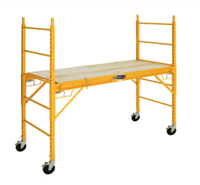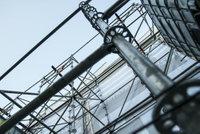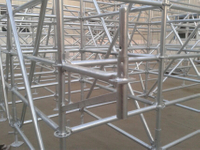Content Menu
● Understanding Scaffolding Access Ladders
● Key Features of Scaffolding Access Ladders
● Types of Scaffolding Access Ladders
>> 1. Attachable Scaffold Ladders
>> 2. Portable Ladders
>> 3. Steel Scaffold Ladders
>> 4. Aluminum Scaffold Ladders
>> 5. Extension Scaffold Ladders
● Safety Standards and Regulations
>> OSHA Requirements for Scaffolding Access Ladders
>> Competent Person Requirement
● Choosing the Best Scaffolding Access Ladder for Construction Safety
>> Factors to Consider
>> Recommended Ladder Types
● Best Practices for Using Scaffolding Access Ladders
● Conclusion
● FAQ
>> 1. What is the safest type of scaffolding access ladder?
>> 2. How far should a scaffolding ladder extend above the platform?
>> 3. Can crossbraces be used as ladders on scaffolding?
>> 4. What angle should a scaffolding access ladder be set at?
>> 5. Are workers required to wear fall protection when using scaffolding access ladders?
● Citations:
In the construction industry, safety is paramount, especially when working at heights. One of the most critical pieces of equipment ensuring safe access to elevated work areas is the scaffolding access ladder. Selecting the best scaffolding access ladder can significantly reduce the risk of falls and injuries on construction sites. This comprehensive article explores the features, types, safety standards, and best practices for scaffolding access ladders to help construction professionals make informed decisions.

Understanding Scaffolding Access Ladders
A scaffolding access ladder is a ladder specifically designed to provide safe and secure access to scaffolding platforms. Unlike regular ladders, these ladders are engineered to integrate with scaffolding systems, offering stability and compliance with safety regulations.
Key Features of Scaffolding Access Ladders
- Attachment Mechanism: Most scaffolding access ladders come with clamps or hooks to securely attach to scaffolding frames, preventing movement during use.
- Material: Commonly made from powder-coated steel or aluminum for durability and corrosion resistance.
- Height and Extension: Designed to extend at least 3 feet above the platform level for safe handholds, especially if portable ladders are used.
- Rung Spacing and Width: Rungs are spaced to OSHA standards, typically no more than 24 inches from the ground to the bottom rung, ensuring ease of access.
- Load Capacity: Rated to support workers and their tools, usually up to 300 pounds or more.
- Non-Slip Rungs: Many scaffolding access ladders feature serrated or slip-resistant rungs to reduce the risk of slipping, especially in wet or dusty conditions.
Types of Scaffolding Access Ladders
1. Attachable Scaffold Ladders
These ladders are purpose-built to attach directly to scaffold frames via swivel clamps or hooks. They provide a fast, convenient, and OSHA-compliant way to access elevated platforms. Because they are fixed to the scaffold, they reduce the risk of ladder movement and enhance worker confidence.
2. Portable Ladders
Traditional ladders that can be moved and positioned as needed. When used with scaffolding, they must extend at least 3 feet above the platform and be tied off or secured. Portable ladders are versatile but require careful setup to ensure safety.
3. Steel Scaffold Ladders
Made from steel, these ladders offer robust strength and durability, ideal for heavy-duty construction environments. Steel ladders are resistant to bending and can withstand harsh weather conditions, making them suitable for long-term use on demanding sites.
4. Aluminum Scaffold Ladders
Lighter than steel but still strong, aluminum ladders are easier to transport and set up, suitable for projects requiring frequent ladder movement. Aluminum ladders also resist rust, which is beneficial in damp or coastal environments.
5. Extension Scaffold Ladders
These ladders can be extended to reach higher scaffold platforms and then securely locked in place. They offer flexibility for multi-level scaffolding but must be used with caution to ensure stability.
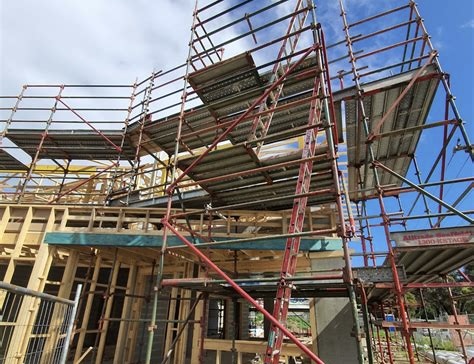
Safety Standards and Regulations
OSHA Requirements for Scaffolding Access Ladders
- Ladder Placement: Ladders must be used when scaffold platforms are more than 2 feet above or below the access point.
- Extension Above Platform: Portable ladders must extend at least 3 feet above the scaffold platform to provide secure handholds.
- Securing Ladders: Ladders must be secured to prevent movement. Attachments must be compatible with the scaffold type.
- Rung Height: The bottom rung should be no more than 24 inches from the ground or platform to facilitate safe climbing.
- Load Rating: Ladders must support the intended load, including workers and tools, typically rated for a minimum of 300 pounds.
- Fall Protection: If scaffolds exceed 10 feet in height, fall protection measures such as harnesses or guardrails are mandatory.
- Inspection: Ladders must be inspected regularly for defects such as cracks, corrosion, or loose components before each use.
Competent Person Requirement
A competent person must inspect scaffolding and ladders regularly to identify hazards and ensure compliance with safety standards. This individual is responsible for training workers and enforcing safe practices on site.
Choosing the Best Scaffolding Access Ladder for Construction Safety
Factors to Consider
| Factor | Importance | Recommendation |
| Material | Durability and weight | Steel for heavy-duty, aluminum for portability |
| Attachment Type | Secure fit to scaffolding | Swivel clamps or hooks designed for scaffold frames |
| Height and Extension | Safe access above platform | At least 3 feet extension above platform |
| Load Capacity | Support for worker and tools | Minimum 300 lbs rated |
| Compliance | Meets OSHA and local safety regulations | Certified scaffold ladders with safety labels |
| Ease of Use | Quick installation and removal | Snap-on or attachable ladders with clamps |
| Slip Resistance | Safety during climbing | Non-slip rungs or coatings to prevent slips |
Recommended Ladder Types
- Snap-On Scaffold Access Ladders: These ladders feature welded swivel clamps for quick attachment and removal, providing secure and OSHA-compliant access.
- Steel Scaffold Ladders: Best for sites requiring high durability and resistance to wear and tear.
- Portable Extension Ladders: Suitable for smaller projects or where scaffold-specific ladders are unavailable, but must follow OSHA extension and securing rules.
- Lightweight Aluminum Ladders: Ideal for projects where ladders need to be moved frequently, balancing safety with portability.
Best Practices for Using Scaffolding Access Ladders
- Inspection Before Use: Check for damaged rungs, loose clamps, corrosion, or any structural defects.
- Proper Angle: Set ladders at a 75 to 80-degree angle to prevent tipping and ensure stability.
- Secure Attachment: Ensure ladders are firmly attached or tied off to prevent movement during use.
- Three-Point Contact: Always maintain two hands and one foot or two feet and one hand on the ladder while climbing to maximize stability.
- Avoid Overreaching: Keep your body centered between the rails to prevent losing balance.
- Fall Protection: Use harnesses and guardrails when working at heights above 10 feet.
- Training: Workers must be trained on ladder and scaffold safety, including proper use and fall protection.
- Clear Area Around Ladder Base: Keep the base free from debris, tools, or materials that could cause tripping or ladder instability.
- Weather Considerations: Avoid using ladders during high winds or slippery conditions unless additional safety measures are in place.
- Use Ladder Accessories: Consider ladder stabilizers, anti-slip feet, and safety cages for enhanced protection.
Conclusion
Choosing the best scaffolding access ladder is crucial for construction safety. The ideal ladder should be durable, securely attachable to scaffolding frames, compliant with OSHA standards, and suitable for the specific site conditions. Proper ladder use, regular inspections, and worker training further enhance safety and reduce the risk of falls. By prioritizing these factors, construction sites can maintain safer environments and protect their workforce effectively.
Remember, no matter how advanced the scaffolding access ladder is, it is only as safe as the way it is used. Always follow safety protocols, use fall protection where required, and ensure that all workers are trained and aware of the risks involved with working at heights.
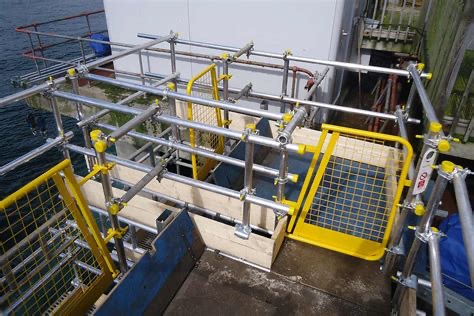
FAQ
1. What is the safest type of scaffolding access ladder?
The safest type is a purpose-built attachable scaffold ladder with swivel clamps that securely fasten to the scaffold frame, ensuring stability and OSHA compliance.
2. How far should a scaffolding ladder extend above the platform?
Portable ladders must extend at least 3 feet above the scaffold platform to provide secure handholds, though purpose-built attachable ladders may not require this if handholds are available.
3. Can crossbraces be used as ladders on scaffolding?
No, crossbraces are not designed as access points and cannot be used as ladders due to safety risks.
4. What angle should a scaffolding access ladder be set at?
The ladder should be set at an angle between 75 and 80 degrees from vertical to maximize stability and reduce the risk of tipping.
5. Are workers required to wear fall protection when using scaffolding access ladders?
Yes, if the scaffold height exceeds 10 feet, workers must use fall protection such as harnesses or guardrails to prevent injuries from falls.
Citations:
[1] https://aaitscaffold.com/scaffold-steel-ladders/scaffold-steel-ladder-safety-on-construction-sites/
[2] https://scaffoldingrentalandsales.com/access-ladder-for-snap-on-scaffolding/
[3] https://www.safex.us/scaffold-tech-bulletin/
[4] https://www.shutterstock.com/search/scaffold-ladder
[5] https://www.youtube.com/watch?v=HKytKZ3833k
[6] https://www.youtube.com/watch?v=MDyuqynCdzo
[7] https://dss.net/guide-to-ladders-and-scaffolding-in-construction/
[8] https://www.dhglabe.com/blog/here-are-some-scaffolding-answers
[9] https://www.osha.gov/sites/default/files/2018-12/fy15_sh-27683-sh5_Level_2_Evaluation_Fall_Prevention_Exam_English_Answers.pdf
[10] https://biljax.com/product/access-ladder
[11] https://www.scaffoldssupply.com/Scaffold-Side-and-End-Brackets-s/223.htm
[12] https://www.westlake.com/safety_guidelines/PLQ_Safety_Guidelines/Safety/HSP%20313.pdf
[13] https://www.istockphoto.com/photos/scaffold-and-ladder-safety
[14] https://riskmanagement.nd.edu/assets/445123/ladder_and_scaffold_procedure_october_2019.pdf
[15] https://aaitscaffold.com/blog/top-7-scaffolding-questions-with-answers/
[16] https://www.osha.gov/sites/default/files/2020-03/Ladders%20and%20Lift%20Safety%20Answer%20Key_0.pdf
[17] https://www.scaffoldssupply.com/6ft-Access-Ladder-p/lf-65h-w15.htm
[18] https://gbca.com/hard-hat-chat/gbca-safety-toolbox-talk-scaffold-access-requirements/
[19] https://www.badgerladder.com/6-foot-access-ladder/
[20] https://www.saiaonline.org/files/Scaffold%20Ladder%20Safe%20Operating%20Procedure2.pdf
[21] https://www.industrialproducts.com/ladders-lifts-scaffolding/fixed-ladders/fixed-access-ladders.html
[22] https://www.reddit.com/r/OSHA/comments/1bp6rfv/to_all_you_safety_officers_ladders_are_safer_than/
[23] https://www.industrialproducts.com/blog/post/laddersliftsscaffolding/ladder-types-for-construction-work
[24] https://www.bpsdepot.co.uk/blog/types-of-scaffolding-and-their-uses
[25] https://www.saiaonline.org/files/Scaffold%20Ladder%20Safe%20Operating%20Procedure2.pdf
[26] https://bobistheoilguy.com/forums/threads/scaffold-safety.361332/
[27] https://scaffoldexpress.com/collections/scaffold-ladders
[28] http://gbca.com/hard-hat-chat/gbca-safety-toolbox-talk-scaffold-access-requirements/
[29] https://www.homedepot.com/b/Building-Materials-Scaffolding/N-5yc1vZaqfm
[30] https://www.mbawpa.org/assets/Toolbox-Talks-Chapter-Eight-Scaffolds-and-Ladders.pdf
[31] https://www.osha.gov/laws-regs/standardinterpretations/1987-08-11
[32] https://www.osha.gov/sites/default/files/publications/osha3150.pdf
[33] https://www.shutterstock.com/search/ladder-on-scaffolding
[34] https://scaffoldexpress.com/products/5-scaffolding-access-ladder
[35] https://www.alamy.com/stock-photo/ladder-scaffolding.html
[36] https://www.youtube.com/watch?v=_PAUJai1Q1o
[37] https://www.youtube.com/watch?v=8_lfU0pP8b4
[38] https://www.alamy.com/stock-photo/scaffolding-ladder.html
[39] https://www.youtube.com/watch?v=ksig5sqCvjc
[40] https://www.youtube.com/playlist?list=PLUyWkHwckhS5iewSjjaHDINRiRYiZNnoA
[41] https://www.youtube.com/watch?v=VofdGEzFLRI
[42] https://www.youtube.com/watch?v=O3ORkQTY4P4
[43] https://www.youtube.com/watch?v=3lWj1I6bS6c
[44] http://www.osha.gov/video
[45] http://www.osha.gov/etools/scaffolding/faqs
[46] https://scaffoldingrentalandsales.com/scaffolding-frequently-asked-questions-faqs/
[47] https://www.healthandsafetytips.co.uk/forums/viewtopic.php?t=16371
[48] https://quizlet.com/199358342/ladder-and-scaffold-safety-flash-cards/
[49] https://www.safex.us/scaffold-tech-bulletin/
[50] http://www.osha.gov/etools/construction/falls/scaffold-access
[51] https://www.safetysourceonline.com/testquestions/C015EE-SCAFFOLD%20SAFETY.pdf
[52] https://www.agc.org/sites/default/files/Files/Safety%20&%20Health/2%20Scaffolds,%20Ladders,%20&%20Lifts.pdf
[53] https://www.cambridgescaffolding.com/access-scaffolding-questions
[54] https://quizlet.com/233631403/ladders-scaffold-flash-cards/
[55] http://forum.iosh.co.uk/posts/t81924-SCAFFOLDING-LADDER-ACCESS
[56] https://www.istockphoto.com/photos/ladder-scaffold
[57] https://www.worksafebc.com/resources/health-safety/videos/scaffold-ladder-improper-use?lang=en
[58] https://www.youtube.com/watch?v=lqXYDlOSOOs













